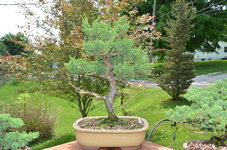Pigskin Pete
Yamadori
Here is a tree I've been working since late summer of last year when I bought it from the local nursery. I don't think it will ever be a "show" quality tree, but it has a rugged look I enjoy and I'm learning a lot by taking my time with it.
Here it is when I bought it, except I jinned that branch before pics.

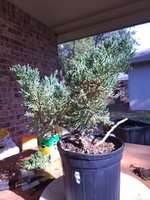
I then pruned it and kept it in it's nursery soil over the fall. Overwintered without issue. Early this spring, I repotted it. 1:1:1, pine bark chips, perlite, and compost soil. I think I would choose a different pot if I was redoing it. I would also avoid the mound style I purposely went for here .
.
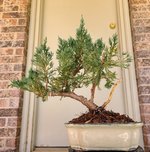
Looking at photo dates, that was mid February. After that I let it sit and relax, just watering it and watching it. I played with adding moss from my back yard.

Now that it is mid- Spring and getting warmer here in North TX, I decided to prune and style just a bit while there is still time in the growing season to recover before fall.
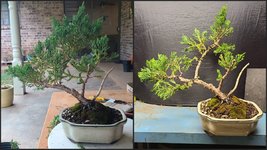
One more with a change of branch direction and pad.
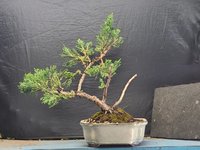

I will let him chill through the fall and winter. My next goals are to keep him alive, address the potting and soil, and possibly consider the changes below...
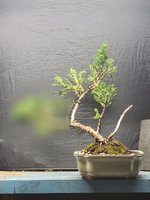
I know they aren't the best for bonsai, but I'm learning a lot with the parsons that I am collecting! Thoughts or opinions are welcome. I have lots to learn.
Here it is when I bought it, except I jinned that branch before pics.


I then pruned it and kept it in it's nursery soil over the fall. Overwintered without issue. Early this spring, I repotted it. 1:1:1, pine bark chips, perlite, and compost soil. I think I would choose a different pot if I was redoing it. I would also avoid the mound style I purposely went for here

Looking at photo dates, that was mid February. After that I let it sit and relax, just watering it and watching it. I played with adding moss from my back yard.

Now that it is mid- Spring and getting warmer here in North TX, I decided to prune and style just a bit while there is still time in the growing season to recover before fall.

One more with a change of branch direction and pad.


I will let him chill through the fall and winter. My next goals are to keep him alive, address the potting and soil, and possibly consider the changes below...

I know they aren't the best for bonsai, but I'm learning a lot with the parsons that I am collecting! Thoughts or opinions are welcome. I have lots to learn.


